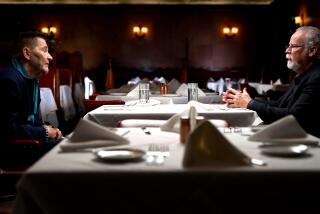‘Shots’: Crime-Photo Gawking, Not Insight
- Share via
Late in the Court TV documentary “Shots in the Dark,” host Harold Evans offers a rationale for the heavy use of crime photos as a staple in daily newspapers.
“The overwhelming virtue of what might otherwise be a shameless voyeurism,” says Evans, “is that we are forced to reflect on our impulses, our insecurities and on the suffering of others who might so easily be us.”
With hot air like that floating about, it’s not hard to see why “Shots” is such a dizzy-headed approach to a serious subject.
Dress it up as you like, gawking at a traffic accident is just that: gawking.
“Shots” purports to explore why crime and blood fascinate photographers and whether the current mania for security cameras poses a threat to privacy. Thrown in for good measure is the chestnut about whether criminals share certain facial characteristics.
But except for trotting out the usual suspects--photo editors talking about pictures making events more vivid, an ACLU lawyer worried about pictures being only “an edited view of reality”--”Shots” seems more like just an excuse to show classic crime photos.
And what classics they be!
Ruth Snyder getting fried in the electric chair. Dutch Schultz in his death throes. A dead mobster whose jaws still chomp his cigar. Celebrity mug shots and the O.J. covers from Time and Newsweek. Patty Hearst on a bank job. And several news-noir shots by the tabloid shooter Weegee.
“Shots” would like to pose as a well-reported, high-minded “Frontline”-style documentary. But its heart is closer to those reality TV shows whose unblinking camera follows cops on home visits to the brawling, boozing, bail-skipping, spouse-whuppin’ lower classes.
One of subjects of “Shots” is Tyrone Hancock, Newark Police Department crime-scene photographer. The implication is that Hancock’s photographic specialty--grisly though it may be--is a vital step in bringing the guilty to justice.
But no evidence is provided that the Newark department solves more murder cases than photographer-free police departments or that Hancock’s pictures have ever proved crucial.
When Hancock tells us he leaves his work at the office and refuses to brood about what he has seen, he comes across less as a world-weary crime fighter than a fellow with a compartmentalized civil service existence.
Todd Maisel, photographer for the New York Daily News, is more engaging, seen racing from one police call to another hoping to scoop the competition (“We got it and nobody else does,” he exults to his editor) and snatch that street-sale boosting front-page picture.
The bane of his life is the determination of beat cops to shoo him away from the action. “Anywhere they don’t want me to be, that’s where I want to be,” said Maisel, in a near-perfect recitation of the news photographers’ credo.
So why does having a picture of an otherwise unremarkable big-city event--a tenement fire in which no one dies, a threatened suicide by an ex-Marine--make that event newsworthy? “Shots” gives us no clue.
As former editor of the Sunday (London) Times and editorial director of the New York Daily News, Evans might have been expected to assemble some of his editorial equals and put some tough questions to them about exploitation and what he calls the “pornography of violence.”
Maisel, unwittingly, gets off a line that is now the definition of bad timing. In bemoaning the fate of a New York crime photographer in an era when violent crime has dropped sharply, Maisel says that his job is to bring “the horror of the streets to people’s minds, and today we’ve got less going on.”
Maisel, of course, is to be forgiven. Who could have imagined the atrocity of Sept. 11, when the nation and the practitioners of news photography were faced with an unimaginable horror?
*
“Shots in the Dark” can be seen tonight at 10 on Court TV. The network has rated it TV-14 (may be unsuitable for children younger than 14).
More to Read
Sign up for Essential California
The most important California stories and recommendations in your inbox every morning.
You may occasionally receive promotional content from the Los Angeles Times.













